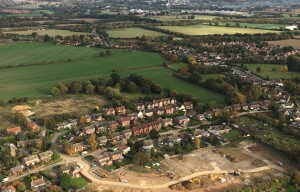Still a Green and Pleasant Land

For most people who live in this ‘green and pleasant land’, the notion of preserving the essentially unspoilt nature of Britain is a compelling one, writes Tony Abel.
The concept of us ‘concreting over our country’ is often cited by those opposed to the building of the new homes that, ironically, almost everyone agrees we need.
So it was interesting to see a new survey published last week by Ipsos Mori, which asked people how much of the country they thought actually was ‘concreted over’. Tellingly, the average estimate was 47 per cent; in fact, that is a colossal misconception – the actual figure is just 0.1 per cent.
To put that in context, if the UK was a football pitch, most people think that an area stretching from the goal-line almost top the half-way line is built on, when in reality, the area designated as ‘continuous urban fabric’ would fit into just one of those tiny quarter-circle arcs they take corners from.
So why do we have this massively exaggerated view of how much of our country is built on?
Mainly it is about our point of view. For a start, most of us live in urban areas, and therefore our day-to-day perspective is of developed land. Secondly, we tend to view our surroundings from roads, and it is beside roads that most building happens. So we are bound to get a distorted view.
Some of you will know that flying is one of my hobbies, and those of us lucky enough to be able to view Britain from the air know just how green the country actually is – as a quick look at Google Maps will confirm.
Our perceptions are also coloured by what we see on television and in the media. From the days of the Industrial Revolution, when rural life was transformed by the arrival of big cities, the concept of our green landscapes being gobbled up by development has become part of our national folklore.
Except, it simply isn’t true. Farmland and natural countryside accounts for more than 90 per cent of the land in Britain, and even that figure doesn’t take into account so-called ‘green urban’ spaces such as parks, verges and your own back garden.
This misconception is important, because it is colouring the legitimate debate about the extent to which we develop in the UK. There will always need to be a balance between our need to provide decent housing for everyone and the desire – if not imperative – to preserve the green lungs of Britain.
What is important is that this debate is coloured not by prejudice and misconceptions, but by facts. Even after 300 years of industrialisation, a large increase in the population and the consequent expansion in the number of homes, we are still overwhelmingly a ‘green and pleasant land’. There is plenty of room to ensure everyone has somewhere to live without altering that fundamental national characteristic.